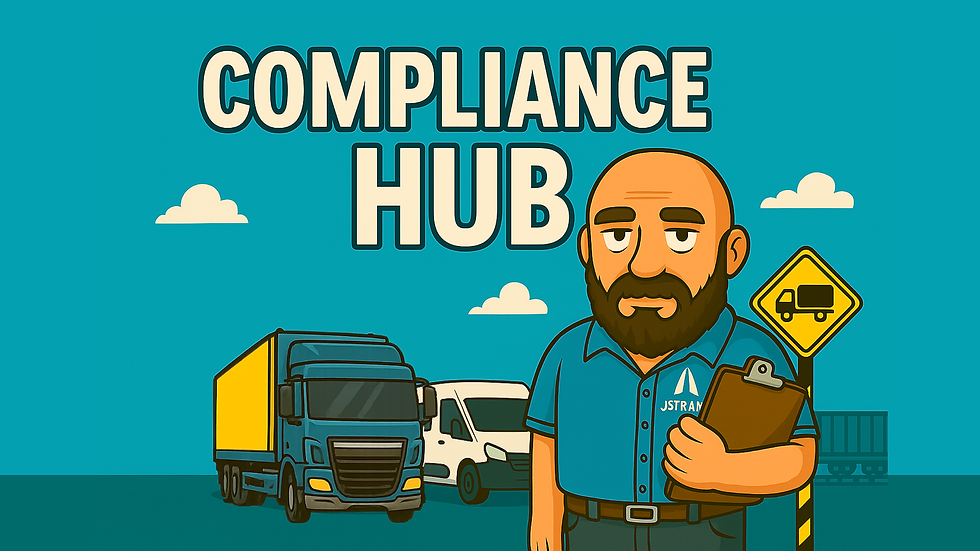

5 .Vehicle Maintenance & Safety Inspections
Ensuring Your Fleet is Safe, Compliant & Roadworthy
Maintaining your vehicles in a roadworthy condition is one of the core responsibilities of a restricted operator licence holder. Whether you operate a single van or a small fleet of HGVs, vehicle maintenance and safety inspections are not just legal obligations—they are crucial for protecting your business, your drivers, and other road users.
Why Vehicle Maintenance Matters
Keeping vehicles in good condition ensures:
-
Compliance with DVSA and Traffic Commissioner expectations
-
Reduced risk of roadside prohibitions or Operator Licence curtailment
-
Fewer breakdowns and lower maintenance costs in the long term
-
Improved safety for drivers and the public
-
Better fuel economy and operational efficiency
Your Legal Responsibilities
As a Restricted Operator, you must:
-
Ensure vehicles are inspected regularly, even if leased or maintained by a third party
-
Have a written maintenance plan for each vehicle and trailer
-
Keep thorough records of inspections, repairs, and servicing
-
Take immediate action to rectify any defects
-
Comply with the Guide to Maintaining Roadworthiness (DVSA)
Key Elements of an Effective Maintenance System
1. Safety Inspection Frequency
-
The DVSA recommends safety inspections every 4-6 weeks for HGVs and trailers, depending on vehicle use and condition.
-
A formal maintenance schedule must be in place and adhered to.
2. Daily Walkaround Checks
-
Drivers should carry out daily walk-around checks before each shift.
-
A documented defect reporting system must be in place.
-
Use either paper-based or digital defect reporting tools, provided records are accessible for inspection.
3. Preventive Maintenance & Servicing
-
Plan for routine servicing based on manufacturer guidelines and mileage/hours of use.
-
Integrate servicing into your overall inspection schedule to avoid duplication or missed checks.
4. Defect Reporting & Rectification
-
Every defect identified must be recorded and rectified promptly.
-
Maintain evidence that defects were repaired before the vehicle returned to service.
5. Record Keeping
-
Keep safety inspection records, servicing history, and defect rectification logs for at least 15 months.
-
Records should include:
-
Date of inspection or repair
-
Details of the work carried out
-
Vehicle details and mileage
-
Inspector’s signature and qualifications
-
Confirmation that the vehicle is roadworthy
Choosing a Maintenance Provider
If you outsource maintenance:
-
Ensure the provider is competent, qualified, and properly equipped
-
Have a formal written agreement in place
-
Review and audit their records regularly to ensure compliance
Use the DVSA Earned Recognition scheme list to identify reputable providers.
Safety Inspection Checklists
The safety inspection must include:
-
Steering, suspension, brakes
-
Tyres, wheels, and lights
-
Mirrors, horns, and wipers
-
Load security
-
Emissions and exhaust
-
Towing equipment (where applicable)
A full list can be found in the DVSA Guide to Maintaining Roadworthiness.
Related Blog posts :
✅ Practical Guides
How Often Should You Carry Out HGV Safety Inspections?
Creating a Simple Vehicle Maintenance Schedule for Small Fleets
What to Include in Your Daily Walkaround Checks
How to Choose a Reliable Maintenance Provider for Your Vehicles
✅ Compliance & Risk
Avoiding DVSA Prohibitions: Common Vehicle Maintenance Failures
Understanding Your Responsibilities as a Restricted Operator Licence Holder
Keeping Digital Maintenance Records: Benefits & Best Practices
✅ Tools & Templates Coming Soon:
Free Vehicle Defect Report Template (PDF/Excel)
Download: Weekly Safety Inspection Checklist Template
Vehicle Maintenance Logbook Template for Small Operators
Need Help Staying Compliant?
At JS Transport Solutions, we offer support packages tailored to restricted operators, including:
-
Maintenance schedule planning
-
Digital defect reporting systems
-
Maintenance provider vetting
-
Compliance audits and Transport Manager consultancy

